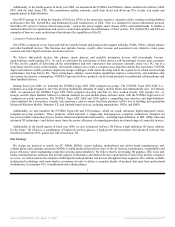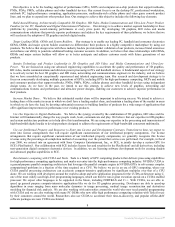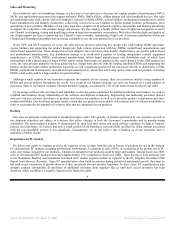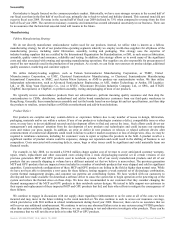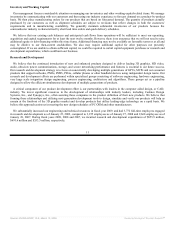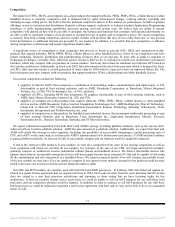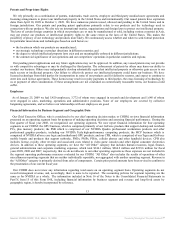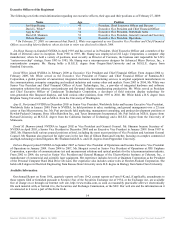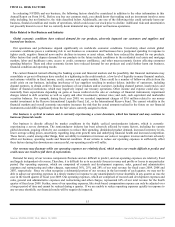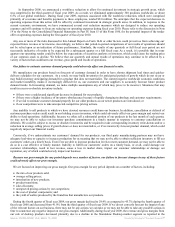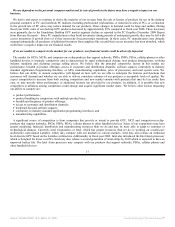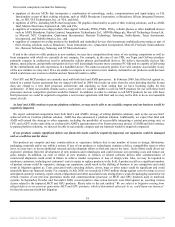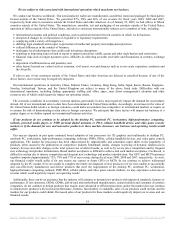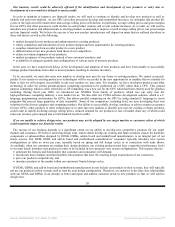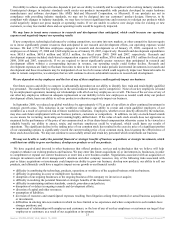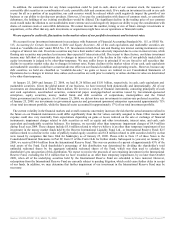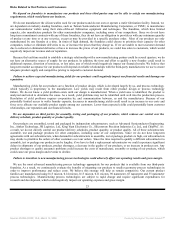NVIDIA 2009 Annual Report Download - page 18
Download and view the complete annual report
Please find page 18 of the 2009 NVIDIA annual report below. You can navigate through the pages in the report by either clicking on the pages listed below, or by using the keyword search tool below to find specific information within the annual report.
ITEM 1A. RISK FACTORS
In evaluating NVIDIA and our business, the following factors should be considered in addition to the other information in this
Annual Report on Form 10-K. Before you buy our common stock, you should know that making such an investment involves some
risks including, but not limited to, the risks described below. Additionally, any one of the following risks could seriously harm our
business, financial condition and results of operations, which could cause our stock price to decline. Additional risks and uncertainties
not presently known to us or that we currently deem immaterial may also impair our business operations.
Risks Related to Our Business and Industry
Global economic conditions have reduced demand for our products, adversely impacted our customers and suppliers and
harmed our business.
Our operations and performance depend significantly on worldwide economic conditions. Uncertainty about current global
economic conditions poses a continuing risk to our business as consumers and businesses have postponed spending in response to
tighter credit, negative financial news and/or declines in income or asset values, which have reduced the demand for our products.
Other factors that could depress demand for our products in the future include conditions in the residential real estate and mortgage
markets, labor and healthcare costs, access to credit, consumer confidence, and other macroeconomic factors affecting consumer
spending behavior. These and other economic factors have reduced demand for our products and could further harm our business,
financial condition and operating results.
The current financial turmoil affecting the banking system and financial markets and the possibility that financial institutions may
consolidate or go out of business have resulted in a tightening in the credit markets, a low level of liquidity in many financial markets,
and extreme volatility in fixed income, credit, currency and equity markets. There could be a number of follow-on effects from the
credit crisis on our business, including insolvency of key suppliers resulting in product delays; inability of customers, including
channel partners, to obtain credit to finance purchases of our products and/or customer, including channel partner, insolvencies; and
failure of financial institutions, which may negatively impact our treasury operations. Other income and expense could also vary
materially from expectations depending on gains or losses realized on the sale or exchange of financial instruments; impairment
charges related to debt securities as well as equity and other investments; interest rates; and cash, cash equivalent and marketable
securities balances. For example, during fiscal year 2009, we recorded impairment charges of $5.6 million related to our money
market investment in the Reserve International Liquidity Fund, Ltd., or the International Reserve Fund. The current volatility in the
financial markets and overall economic uncertainty increases the risk that the actual amounts realized in the future on our financial
instruments could differ significantly from the fair values currently assigned to them.
Our business is cyclical in nature and is currently experiencing a severe downturn, which has harmed and may continue to
harm our financial results.
Our business is directly affected by market conditions in the highly cyclical semiconductor industry, which is currently
experiencing a severe downturn. The semiconductor industry has been adversely affected by many factors, including the current
global downturn, ongoing efforts by our customers to reduce their spending, diminished product demand, increased inventory levels,
lower average selling prices, uncertainty regarding long-term growth rates and underlying financial health and increased competition.
These factors, could, among other things, limit our ability to maintain or increase our sales or recognize revenue and in turn adversely
affect our business, operating results and financial condition. If our actions to reduce our operating expenses to sufficiently offset
these factors during this downturn are unsuccessful, our operating results will suffer.
Our revenue may fluctuate while our operating expenses are relatively fixed, which makes our results difficult to predict and
could cause our results to fall short of expectations.
Demand for many of our revenue components fluctuate and are difficult to predict, and our operating expenses are relatively fixed
and largely independent of revenue. Therefore, it is difficult for us to accurately forecast revenue and profits or losses in any particular
period. Our operating expenses, which are comprised of research and development expenses, sales, general and administrative
expenses and restructuring and other charges, represented 36%, 25% and 28% of our total revenue for fiscal years 2009, 2008 and
2007, respectively. Since we often recognize a substantial portion of our revenue in the last month of each quarter, we may not be
able to adjust our operating expenses in a timely manner in response to any unanticipated revenue shortfalls in any quarter as was the
case in the fourth quarter of fiscal year 2009. Our operating expenses, which are comprised of research and development expenses and
sales, general and administrative expenses and restructuring and other charges, represented 66% of our total revenue for the fourth
quarter of fiscal year 2009. Further, some of our operating expenses, like stock-based compensation expense can only be adjusted over
a longer period of time and cannot be reduced during a quarter. If we are unable to reduce operating expenses quickly in response to
any revenue shortfalls, our financial results will be negatively impacted.
15
Source: NVIDIA CORP, 10-K, March 13, 2009 Powered by Morningstar® Document Research℠



